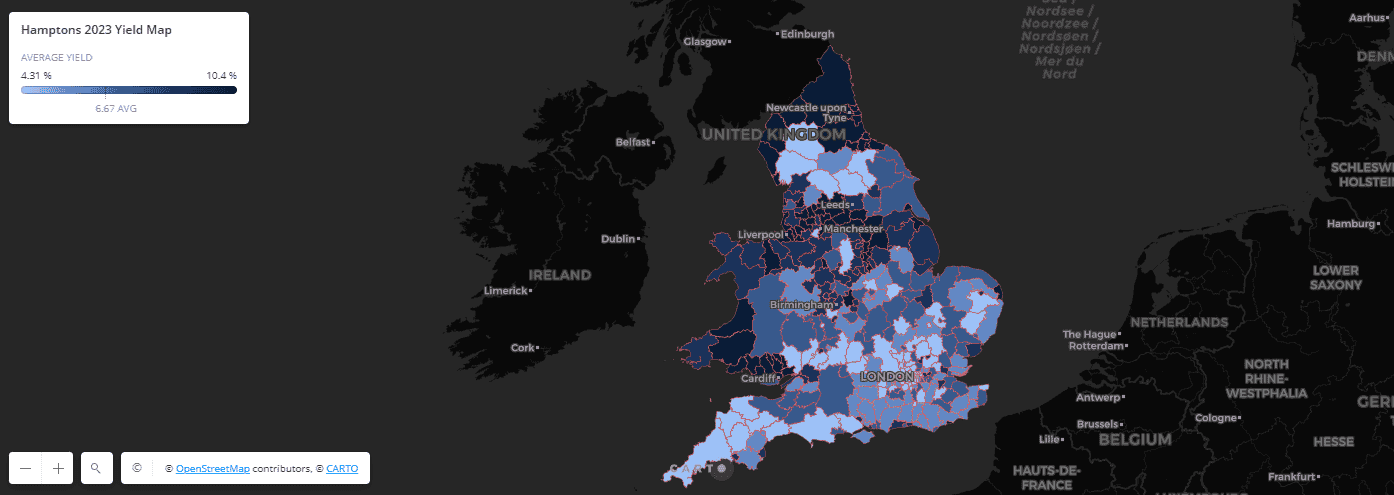High Yield Property Investments: 10 Strategies for 8%+ Returns in the UK
The UK’s top high-yield property investment hotspots for 2025 include Nottingham (8.7% yields), Bradford (12.0% in BD1), Sunderland (11.2% in SR1), and Leeds (8.6%), with Derby and Newcastle also offering strong returns. These areas combine affordable property prices, high tenant demand, and regeneration projects, making them ideal for investors targeting 8%+ rental yields.
Key Takeaways
Nottingham, Bradford & Sunderland Lead with 8%+ Yields
Nottingham’s NG1 postcode offers 8.7% gross yields, while Bradford’s BD1 hits 12%. Sunderland’s SR1 area delivers 11.2%, driven by low property prices and regeneration projects like Riverside Sunderland.
Economic & Market Trends Favor Northern England
Northern cities (Leeds, Newcastle, Derby) outperform due to rising rents (+9.7% in 2023) and limited housing supply. Scotland (East Ayrshire) and the North East also show high yields.
HMOs & Diversification Boost Returns
Houses in Multiple Occupation (HMOs) average 8.4% yields, with some reaching 12%. Terraced houses and flats (5.5–5.8% yields) are safer bets for balanced portfolios.
Risk Management is Key
High-yield properties (8–13% returns) provide cash flow buffers against market downturns. Focus on areas with strong tenant demand, transport links, and regeneration (e.g., Liverpool Waters, Derby’s 2030 Masterplan).
Imagine investing in property and securing returns that exceed 8%, even in a market that many view as volatile. With the right strategies, high-yield property investments are attainable and potentially lucrative, especially with an eye towards 2025. Understanding where and how to invest is crucial for maximising profit as real estate evolves.
In property investment, one must differentiate between gross and net rental yields to make informed decisions. The UK offers a diverse landscape, with locations like Nottingham, Derby, and Leeds presenting golden opportunities for remarkable returns. Meanwhile, understanding economic indicators and market trends will help investors position themselves favorably in this dynamic sector.
This article delves into ten strategic approaches for achieving returns over 8% in the property market by 2025. From examining hotspot locations and tenant demand to exploring innovative investments like HMOs and diversifying property portfolios, we uncover the pathways to success. Join us to navigate the complexities of property investment and learn how to manage risks effectively for secured and consistent returns.
Understanding Rental Yields:
Gross vs. Net
Understanding rental yields is crucial for property investors. Rental yield shows a property’s income as a percentage of its value. There are two types: gross and net rental yields.
Gross Rental Yield
- Gross rental yield is calculated by dividing the annual rental income by the property’s purchase price or current value.
- Formula: (Monthly Rental Income x 12) / Property Price.
- This figure excludes expenses like maintenance and management.
Net Rental Yield
- Net rental yield accounts for all additional costs.
- This includes property taxes, repairs, and management fees.
- It gives a clearer picture of actual profit.
Using a rental yield calculator can help evaluate potential returns. These tools factor in gross and net yields, aiding smart investment decisions.
Here’s a brief table for clarity:
Yield Type | Calculation | Includes Costs? |
|---|---|---|
Gross Rental Yield | (Annual Rental Income ÷ Property Value) x 100 | No |
Net Rental Yield | [(Annual Income – Costs) ÷ Property Value] x 100 | Yes |
Understanding these yields helps one better assess property investments, especially in areas like the East Midlands or West Midlands.
UK Buy-To-Let Yield Map 2025: A Strategic Starting Point
The UK Buy-To-Let Yield Map for 2025 is essential for investors looking for high-yield property investments. As property prices stabilise and rental rates rise, average yields across the UK have improved to 5.60%. For those seeking exceptional returns, regions like Scotland and the North East offer some of the highest rental yields.

source: https://www.hamptons.co.uk/research/interactive-yield-map#/
Noteworthy Yield Areas:
- Nottingham, East Midlands: This area shines with a notable 7.06% rental yield, making it a lucrative option for investors.
- Bradford’s BD1: With a remarkable 12.0% yield, this location is the top choice for those seeking high returns.
- Nottingham’s NG1: Boasts yields of 8.7%, offering potential capital growth and passive income.
According to Natwest, properties yielding 6% and above are considered very good for investors. This makes areas like Nottingham and Bradford exceptionally valuable. Considering initial costs, consider transport links and the average property price for the best investment outcome. Regions like East Ayrshire and the South West also present promising opportunities, encouraging local and overseas investors to explore the evolving property market.
Identifying Hotspot Locations: Nottingham, Derby, and Leeds
Identifying hotspot property investment locations is crucial for investors looking to maximise returns. Nottingham, Derby, and Leeds are standout examples in the UK market.
Nottingham: In the East Midlands, Nottingham’s NG1 and NG7 postcodes lead with impressive average gross rental yields of 8.7%. The property market thrives due to significant regeneration projects like the Island Quarter and Broad Marsh Area. The area offers excellent transport links with direct rail services to major cities, making it a prime location for buy-to-let investors.
Derby: Derby emerges as a key investment hotspot for 2025. Its robust industrial base, housing global businesses like Rolls-Royce, aligns well with the £3.5 billion 2030 Derby Masterplan. Derby’s strategic proximity to the M1 and robust road, rail, and air transport further enhances its appeal to property investors.
Leeds: A new real estate listing in Leeds offers an enticing 8.6% yield on a one-bedroom buy-to-let apartment with current tenants for immediate income. This opportunity highlights Leeds as an attractive option for investors seeking high-yielding properties.
Location | Average Yield | Key Factors |
|---|---|---|
Nottingham | 8.7% | Regeneration projects |
Derby | N/A | Strong industrial base |
Leeds | 8.6% | Immediate income |
These hotspots offer strong capital growth and passive income potential for overseas investors exploring rental properties.
Analysing Market Trends and Economic Indicators
Understanding market trends and economic indicators is key when investing in high-yield properties. Rental yields differ across the UK. Northern areas like Sunderland, Bradford, and Leeds offer returns above 8.5%. In 2024, rents jumped by 9.7%, and experts predict another 5% growth in 2025. This growth stems from high tenant demand and limited supply.
Economic factors also play a role. Higher living costs and rising interest rates push many to rent instead of buying, keeping rental demand high. Demographic shifts, such as population growth and local development, impact property prices and yields.
Interest rates matter, too. Lower rates make mortgages cheaper and boost market demand. Consider these changes when considering property investments.
Here’s a quick look at rental yield by region:
Region | Rental Yield |
|---|---|
Sunderland | Above 8.5% |
Bradford | Above 8.5% |
Leeds | Above 8.5% |
In short, staying informed about market trends and economic factors helps make wise property investments.

Emphasising Tenant Demand and Neighbourhood Growth
High-yield property investments thrive in areas with strong tenant demand and neighbourhood growth. Liverpool is a prime example due to its ambitious regeneration projects, such as Liverpool Waters. This £5 billion investment aims to boost tenant demand by creating new spaces and jobs.
Key Locations with High Yield Potential
- Liverpool: The Audley House development highlights increased rental demand in its redeveloped areas. Investors can expect high rental yields and capital growth here.
- Newcastle: Known as a top buy-to-let area due to affordable property prices and a growing population. This leads to a robust tenant demand.
- Northern England: Places like Sunderland, Bradford, and Leeds deliver yields above 8.5%, attracting investors.
Location | Key Benefits | Average Yields |
|---|---|---|
Liverpool | Regeneration boosts tenant demand | High |
Newcastle | Affordable housing, growing population | Robust |
Sunderland, Bradford, Leeds | Strong rental demand | >8.5% |
Investing in these zones can provide lucrative passive income due to affordable initial costs and potential for capital growth. Overseas investors are also drawn to these regions’ promising property markets.
Top Investment Property Opportunities in the UK
Sunderland and Newcastle: Promising Markets
Sunderland and Newcastle stand out in the property market because they promise high yields and capital growth. Sunderland’s SR1 postcode offers an enticing average gross rental yield of 11.2%. Low property prices and a large student population drive this. The average asking price in this area is £63,081. The Riverside Sunderland masterplan, a £100 million+ investment, will create 1,000 new homes and 10,000 jobs by 2030. This further enhances its appeal to investors. The city benefits from excellent transport links to Newcastle, Durham, and London.
Newcastle, particularly in the NE1 postcode, has strong rental demand. This area attracts interest due to its vibrant nightlife and modern developments around the Quayside—property investments in central Newcastle start at £146,750. The city’s ongoing regeneration projects promise good occupancy levels and capital growth.
City | Postcode | Average Price | Rental Yield | Key Features |
|---|---|---|---|---|
Sunderland | SR1 | £63,081 | 11.2% | Low prices, student population, and transport links |
Newcastle | NE1 | £146,750 | High | Nightlife, Quayside, regeneration projects |
Invest now for potential passive income and capital appreciation.
Innovative Strategies: Houses of Multiple Occupancy (HMOs)
Innovative Strategies: Houses in Multiple Occupation (HMOs)
Houses in multiple Occupations (HMOs) are a top choice for high-yield property investments. With average returns of 8.4%, they surpass many other property types. Investors in HMOs might even see gross yields as high as 12%.
HMOs can be bought starting at around £220,000. They offer the chance for a significant rental income, often over £27,480 per year. Sometimes, an HMO license isn’t needed, adding to their appeal.
Many investors enjoy a hands-free experience with fully managed HMOs. These come with guaranteed rental income options.
Here are some key benefits of investing in HMOs:
- High Yield Potential: Yields can reach up to 12%.
- Lower Initial Costs: Entry prices start around £220,000.
- Ease of Management: Fully managed options are available.
- Strong Income Stream: Potential rental income exceeds £27,480 annually.
HMOs provide a lucrative and manageable way to earn passive income in the property market. Their structure and benefits make them a wise investment choice, particularly for those aiming to maximise returns with minimal involvement.
Diversifying Property Types for Maximum Profit
Investing in high-yield property can be a lucrative venture. Terraced houses and flats often offer the best returns. Their average yields are 5.80% and 5.58%, respectively. This makes them reliable choices for investors looking for substantial profits.
To boost your income, consider diversifying the types of properties you own. Here’s a quick guide to help you make informed choices:
- Assess Rental Yields: Properties with yields above 6% are ideal.
- Evaluate Maintenance Costs: Ensure low expenses to maximise profit.
- Consider Market Trends: Check property prices and tenant availability.
- Use Tools: A rental yield calculator can simplify your analysis.
A mix of property types can ensure a balanced portfolio. It’s also essential to look beyond returns. Factor in house price trends and local transport links. This can enhance both capital growth and passive income.
Whether considering residential properties in the East Midlands or looking abroad, the right mix can lead to high returns. For many, exploring diverse options is the key to success in today’s property market.
Comprehensive Market Research
Conducting comprehensive market research is key for successful high-yield property investments. Start by analysing location trends such as population growth and local projects. For example, areas like the East Midlands or East Ayrshire might offer promising opportunities due to rapid development and improved transport links.
Here’s a simple checklist to guide your research:
- Population Growth: Examine census data to see if the area attracts new residents.
- Local Development: Look into planned infrastructure projects.
- Interest Rates and Housing Policies: Monitor changes that could impact property prices.
Additionally, evaluating rental yields against house price growth is vital. This helps you understand if buy-to-let investments in areas like the West Midlands or the South West are viable.
Using authoritative data sources is also crucial. To ensure the accuracy of your analysis, access datasets from the HM Land Registry.
A thorough review of average property prices and initial costs can uncover potential risks or rewards. Market research mitigates risks and maximises your chances of achieving passive income and capital growth. Good research empowers smarter investment choices.
Risk Management: Securing Consistent Returns
High-yield property investments are a reliable way to manage investment risks. They offer protection against market fluctuations and economic downturns. This means investors can enjoy more stable returns.
Consistent income from these properties can offset potential declines in property value. It ensures financial stability even in challenging times. A high 8% to 13% yield provides enough cash flow to tackle unexpected problems.
Investing in high-yield properties often delivers quicker returns compared to lower-yield options. This reduces the risk of financial loss, and the increased cash flow from these investments acts as a buffer against various expenses.
Key Benefits of High-Yield Properties:
- Protection: Shields against market ups and downs.
- Steady Income: Offsets declines in property value.
- Strong Cash Flow: Yields between 8% and 13%.
- Quick ROI: Faster returns on investment.
- Expense Buffer: Increased cash flow helps manage costs.
High-yield property investments are a solid choice for securing consistent returns and reducing risks. They provide both financial stability and peace of mind.
Are You Looking For High Yield Property Investments?
DISCOVER EXCLUSIVE OFF-MARKET UK INVESTMENT PROPERTIES THAT OTHERS DON’T SEE!
SKIP THE COMPETITION AND SECURE HIGH-YIELD DEALS BEFORE THEY HIT THE MARKET.
OUR PRE-SOURCED PORTFOLIO OFFERS PREMIUM OPPORTUNITIES WITH MAXIMUM ROI POTENTIAL.
CLAIM YOUR PORTFOLIO ACCESS



